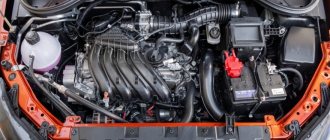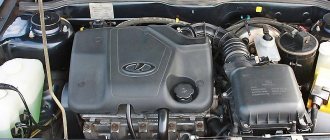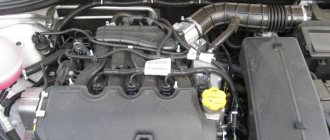Engine VAZ 11183
This is the youngest engine in the Lada engine line. It is practically not used in the Volzhsky plant’s own products at this point in time, with the exception of the remnants of old versions of the “Standard” configuration, but it still finds application in the products produced by the plant under the Datsun brand.
This engine is a logical continuation of the VAZ 21114 engine, which was previously used on the Samara-2 and VAZ 2110 families. The main difference from its predecessor was the increase in the compression ratio in the cylinder to approximately 9.6 units, this was achieved by changing the combustion chamber, which made it possible to lower the maximum torque bar torque from 3000 rpm to 2600, the peak value is 120N/m. Maximum power is achieved at rpm of 5200 and is a low 81 horsepower. The material of the cylinder block, like all other products of the VAZ engine division, is cast iron, which significantly increases its service life and subsequent maintainability. The regulated engine life is 150 thousand kilometers, but in practice, engines with a similar index often last more than 300 thousand with proper care and operation.
Engine advantages:
- Easy to repair and maintain;
- Due to the low compression ratio, it is possible to use cheaper fuel with an octane number of 92 units;
- In the event of a timing belt break or a cooling system pump stop, the valve group does not meet the piston group, which greatly simplifies subsequent repairs and financial costs
- Not a high transport tax, not crossing the 100 horsepower bar.
Minuses:
- Due to the use of an old type piston group, the engine is quite noisy and vibration-loaded;
- There are no hydraulic compensators, which requires adjustment of the valve group every 15 thousand kilometers;
- There is no automatic timing roller tensioner; periodic tightening is required to eliminate the problem of the belt slipping over the rollers.
Dynamics
According to the passport, the Lada Granta with an eight-valve engine accelerates to 100 km per hour in 11.6 seconds. Granta with sixteen valves - in 10.5 seconds. That is, the difference in dynamics is just over a second.
I've driven these cars a lot, and I want to say that the Granta with the eight-clopper on the bottom goes even more vigorously than with the gearbox. Peak torque in the first case is available earlier, already at 3800 rpm. In the second case, at 4200 rpm. That is, for the city, I think the Lada Granta with an 8-valve engine is more than enough.
On the track, the shesnar will, of course, feel more confident. It has power reserves when overtaking. In the summer, when you turn on the air conditioner, the power loss is not so noticeable.
If you are planning to buy a Lada Granta, install a towbar on it and pull a trailer, then I recommend choosing a gear.
Engine VAZ 21116 (11186)
The engine began its life with the advent of the Lada Granta car on the market and in the first years of production it was installed on the “Norma” version, while the younger model engine 11183 was installed on the “Standard” version. Unlike its predecessor, it received a significant number of qualitative changes, which allowed this engine win good reviews among customers as an economical, torquey and at the same time simple and reliable engine.
For the first time in the VAZ engine line, a final plateau honing of the cylinder block was used for an eight-valve engine, just as is done for the VAZ 21126 engine. Oil nozzles were also used for the first time in the cylinder block to cool the connecting rod and piston group. The group itself has become lightweight, similar to its 16-valve counterpart. As a result, it was possible to achieve a significant reduction in the mass and inertia of the SG group, which entailed a significant reduction in noise, vibration and fuel consumption, and also made it possible to increase power and torque. If the previous engine with a heavy piston group had a torque of 120 N/m and developed 81 hp, then the new engine already reached 140 N/m and 87 hp.
The cylinder head has also undergone changes; the engine’s compression ratio has been significantly increased, to 10.1 units; additional mounting points have appeared on the cylinder head for using an automatic timing belt tensioning system.
The gasket between the block and the head is now not impregnated textolite, but two-layer metal, which has significantly improved the tightness of the connection and eliminated most engines from oil leaks.
The introduction of new environmental standards required changing the fuel injection system and exhaust system using a neutral afterburner.
This engine on cars of the first years of production had the index 21116, later, without significant technical changes, it received the index 11186, maintaining all its indicators. According to some information, the change in the index is associated with a change in the supplier of the connecting rod and piston group; if in engine 21116 the supplier was Federal Mogul, then in the engine with index 11186 AvtoVAZ independently mastered the production of ShPG.
Pros:
- Efficiency, acceleration, maintainability;
- Significantly lower level of vibration and noise for an 8 valve engine;
- Lightweight connecting rod and piston group, new technologies in block processing.
Minuses:
- There are no hydraulic compensators; the old engine requires valve adjustment every 15 thousand kilometers;
- The lightweight connecting rod and piston group does not like shock loads and tight driving;
- The use of high-quality AI-95 fuel is required due to the high compression ratio and tendency to detonation.
About the technical component
Technically, engines with 8 and 16 valves are quite different. Although all the difference is stored at the top (engine block head) where the car's camshafts (camshaft) are/are installed. In fact, this is the main design feature, but what I want to note is that almost every engine can be made into either an 8 or 16 valve version. For example, on our VAZs, the engines are very similar, and hypothetically, on the same block, you can fit a different cylinder head, with one or two camshafts.
Engine VAZ 21126
The youngest in the line of 16-valve engines. It has stable and good indicators in terms of fuel consumption, dynamics and reliability.
The engine has been in production for quite a long time, many “childhood diseases” have been corrected by the plant at the moment, plus an extensive knowledge base allows this engine to be used and repaired in almost any corner of the post-Soviet space.
The motor was developed with the production of the Lada Priora car and is currently used on all products of the Volzhsky plant with the exception of 4x4 and Lada Largus.
Unlike its predecessor, the VAZ 21124, the new engine received a qualitatively new treatment of the cylinder walls using Federal Mogul technology, which allows for stable quality of working surfaces. The same company was developing a lightweight connecting rod and piston group specifically for this engine and the crankshaft used on it. This approach to design and preparation made it possible to achieve low vibration load and noise levels of the new motor.
Also, unlike simpler 8-valve engines, the VAZ 21126 engine uses hydraulic pushers, which allow you to automatically compensate for the gap in the valve drive. This implementation freed owners from the need for regular adjustments.
To boost the engine more with the existing technical parameters, the engineers increased the compression ratio to 11 units, which is a very high indicator and has a number of requirements for fuel quality.
The qualitative technical characteristics are as follows: maximum power 98 hp. at 5600 rpm, torque 145 N/m at 4000 rpm.
Pros:
- Low vibration and noise levels;
- With a preferential level of transport tax, it has excellent dynamic performance;
- Hydraulic compensators available
- Maintained ease of maintenance;
Minuses:
- Due to the high compression ratio, the use of high-quality fuel not lower than AI-95 is required
- With improper maintenance and high load, it is not uncommon for the timing belt to break, which entails a meeting of the valves with the connecting rod and piston group.
Malfunctions
Motor 11183 is characterized by malfunctions that are typical for all power units produced by AvtoVAZ OJSC.
| FAULTS | CAUSES | REMEDY METHODS |
| The engine does not warm up to the required temperature. | Thermostat is faulty. | Replace thermostat. |
| Knocking and noise in the engine. | 1. Valve clearances are not adjusted. 2. Wear of the crankshaft main bearings. 3. Wear of connecting rod bearings. 4. Pistons knock | Adjust valve clearances. Malfunctions associated with wear of bearings and the need to replace pistons are recommended to be repaired in a specialized car service center. |
| The engine operates unstably (“speeds float”, “troits”, etc.) | 1. The throttle position sensor is faulty. 2. The valve has burned out. 3. The gasket is broken. 4. The ignition module is faulty. | ŸReplace the faulty sensor. Measure compression in cylinders. If it is below normal, then the malfunction is hidden in the gas distribution mechanism. If compression is normal, the fault must be looked for in the ignition module. |
Engine VAZ 21127 (21129)
The base engine for new Lada products is Lada Vesta and Lada X-Ray. The VAZ 21127 engine has received virtually no significant changes in terms of its “steel” filling. The main changes affected the intake system and engine management system. Unlike the VAZ 21126, the new engine received an intake receiver with variable geometry, which made it possible to improve the engine’s power parameters due to more efficient air supply: at low speeds, air flows through long channels, and after reaching the bar of 4000 rpm, a short intake tract opens. This made it possible to obtain an increase in torque not only at low speeds, but also to maintain them at high speeds. Stable air intake at idle also had a qualitative effect on the noise level of the new engine, which decreased significantly.
Also, for the first time in mass-produced Lada engine models, the control program is focused not on the mass air flow sensor, but on the absolute pressure sensor. This made it possible to increase reliability, since the mass air flow sensor often failed due to dust falling into its operating area.
These seemingly insignificant changes made it possible to add an additional 8 hp. and 5N/m of torque to the indicator of its predecessor and reach a maximum output power of 106 hp. and 150N/m of torque.
This engine also has the VAZ 21129 index, it has exactly the same technical parameters, the difference is the engine mounting points in the engine compartment. The changes were made to install the engine on the Lada Vesta and Lada X-Ray models.
Pros:
Thanks for subscribing!
- Low noise and vibration levels;
- Increased power and torque;
- Improved reliability.
Minuses:
- It retained the disadvantages of the VAZ 21126 engine, namely, there are problems with the timing belt breaking and the use of high-quality high-octane AI-95 fuel is required.
Life time
Let's move on to the power unit data resource. This is a very arbitrary figure, and the final actual service life depends on a large number of indicators.
Here are some of them:
- The quality of the fuel used.
- Oil quality and timing of its replacement.
- Terms of Use.
- Timely service.
There is simply no specific single correct figure in this regard. Based on my experience, I will say that the service life of these motors is approximately the same. That is, they can last 200-250 thousand km with proper maintenance without any problems. There were copies that sold 300-350 thousand.
At the moment, these motors can really be called reliable and unpretentious. And their cast iron block means maintainability.
New eight-bug from AvtoVAZ 11182 - what changes
Acquired deficiencies
The crankshaft of the 1.6 engine is quite modern, it is fully counterbalanced, that is, on the extension of each shaft cheek there is a counterweight (eight in total). Imported motors often have only four counterweights. They save.
“Weight loss” is visible everywhere. The thin rod of the connecting rod merges into a smaller lower head. The piston is lightened to the limit. The area where the piston rings are located and two small “tongues” are left, replacing the previous full skirt.
“Weight loss” is visible everywhere. The thin rod of the connecting rod merges into a smaller lower head. The piston is lightened to the limit. The area where the piston rings are located and two small “tongues” are left, replacing the previous full skirt.
A short piston skirt is in the spirit of modern automotive engineering, but this solution does not have the best effect on engine life. Not only is the piston bearing surface small, but also shifting (lateral vibrations) is more possible than with older, tall pistons.
The connecting rods of the current modification of the engine have become noticeably thinner compared to the old ones, with the index 2108. A high-tech break-off connecting rod cover has also appeared, but the width of the connecting rod bearing has been significantly reduced. Yes, the mass of the connecting rod was reduced a little in this way. But this definitely increased the load on the bearing. At the same time, the width of the neck on the shaft remained the same. It would be quite possible to install a connecting rod with a “wide” lower head.
You can clearly see how narrower the lower connecting rod head is than the crankshaft journal.
You can clearly see how narrower the lower connecting rod head is than the crankshaft journal.











